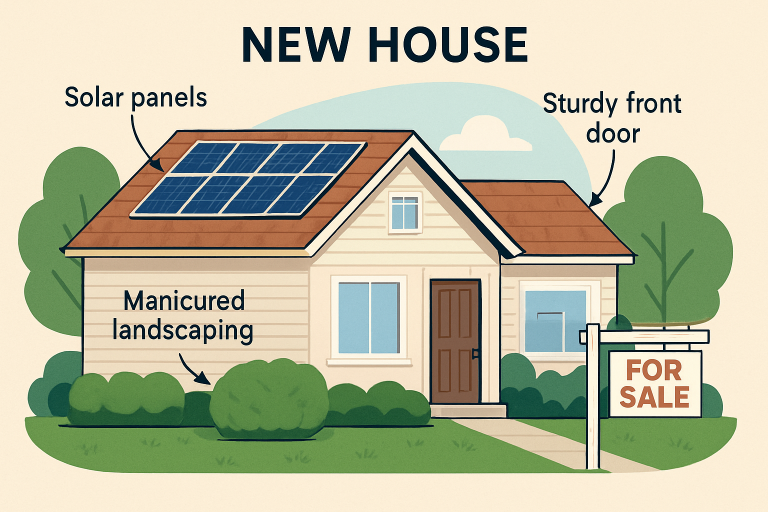Real Estate
How to Spot Quality Features When Searching for a New Home
Key Takeaways
- Identifying quality features in a new home can boost long-term satisfaction and property value.
- Energy efficiency, craftsmanship, and community amenities are essential elements to consider.
- Leveraging available property data and professional advice makes the process smoother and more reliable.
- Avoiding common pitfalls can save buyers time and money in their home search.
Table of Contents
- Emerging Trends in Modern Home Features
- Why First Impressions Matter
- Energy Efficiency and Smart Technology
- Assessing Materials and Craftsmanship
- Community Amenities and Lifestyle
- Doing Your Due Diligence as a Buyer
- Common Pitfalls and How to Avoid Them
- Final Thoughts
Emerging Trends in Modern Home Features
Searching for a new home is both an exciting and complex process, especially as the must-have features evolve. What once were luxury upgrades—like smart home technology or sustainable materials—are now often expected standards among buyers looking for long-term value. In recent years, there has been increased interest in thoughtfully designed indoor-outdoor living, high-efficiency appliances, and homes with versatile spaces adaptable for remote work or personal fitness. If you’re exploring Naples FL homes for sale, it’s essential to identify these qualities early in your search so your investment remains relevant and valuable for years.
Buyers today are also keen to spot amenities that support a comfortable, low-maintenance lifestyle—features including impact-resistant windows, durable roofing materials, and maintenance-free exteriors. According to The New York Times, these considerations have quickly shifted from luxury to necessity, particularly as homeowners prioritize ease and efficiency.
Why First Impressions Matter
Your initial walk-up to a new property delivers more information than you imagine. Well-kept landscaping, freshly painted trim, and a clean, solid front door immediately signal pride of ownership and attention to detail. These cues are more than aesthetic—they provide real insight into how the rest of the property has been maintained. Studies by Realtor.com reveal that curb appeal alone can account for up to a 7% increase in the home’s sale price, making that crucial first impression essential to buyers seeking long-term satisfaction.
Along with aesthetics, structural elements such as healthy shrubbery, safe pathways, and stable fencing contribute to the overall impression. If these features have been overlooked, it’s often a red flag for what you might find inside. Pause to notice any signs of deferred maintenance, water damage near the foundation, or signs of pests—these issues are easier to address before falling in love with the interior.
Energy Efficiency and Smart Technology
One of the hallmark features of high-quality homes today is their focus on efficiency in terms of energy use and daily convenience. Look for homes with modern windows, up-to-date insulation, and advanced HVAC systems. These upgrades can translate to significant energy savings over time. Features like programmable thermostats, tankless water heaters, and energy-efficient lighting are excellent indicators of a property designed with the future in mind.
Smart home features such as integrated lighting controls, automated security systems, and voice-controlled assistants are quickly becoming the norm and can add substantial value to your home. Consumer Reports offers a deep dive into features that stand the test of time to learn which digital upgrades enhance resale value.

Assessing Materials and Craftsmanship
Quality you can see—and feel—should be at the top of your priorities. Examples include solid “wood” doors (not hollow core), durable tile or hardwood flooring, and custom cabinetry with dove-tailed joints. Stroll through potential homes, checking for workmanship in crown molding, tile grout, and cabinet alignment. Faucet fixtures, light switches, and hardware should all feel substantial, not flimsy. Don’t hesitate to ask about repairs, renovations, and who handled the construction—local builders and well-known contractors typically stand by their work with guarantees or warranties.
Be diligent when reviewing recent upgrades. Sometimes, cosmetic updates can mask deeper issues. Open and close doors and windows, test faucets, and examine trim for signs of poor finishing or DIY attempts that may not stand up to daily use. Investing in a reputable home inspector will help ensure nothing is missed beneath the surface.
Community Amenities and Lifestyle
The surroundings of a home can shape your daily experience as much as its interior features. Many developments now offer swimming pools, fitness centers, walking trails, and private parks to create a wealthy lifestyle outside your door. Consider what’s included in the community’s HOA and weigh the costs against added amenities like security, standard area maintenance, and social activities.
Evaluate the broader neighborhood—proximity to schools, public parks, transportation, and shopping can significantly impact your overall quality of life. According to U.S. News & World Report, location remains one of the most critical factors influencing immediate satisfaction and long-term investment value.
Doing Your Due Diligence as a Buyer
Prepare yourself with as much information as possible before making an offer. Always hire a licensed home inspector to spot hidden problems, such as foundation cracks, roof damage, or outdated electrical systems. Review public records and recent property assessments and request proof of repairs or warranties on major systems.
Contact neighbors or review online forums to understand the community and its management. Research recent sales prices for similar properties to ensure you’re being asked for a fair price compared to market averages.
Common Pitfalls and How to Avoid Them
- Skipping the Inspection: Never waive a professional inspection, no matter how perfect a home might seem on the surface.
- Overlooking Future Needs: Anticipate changes in your life—a growing family, work-from-home requirements, or accessibility needs—and evaluate homes accordingly.
- Underestimating Total Costs: Budget for HOA fees, insurance, property taxes, maintenance, and potential upgrades to avoid surprises after closing.
- Emotional Decisions: Don’t let staging or minor upgrades distract you from structural issues or poor layout. Focus on lasting quality, not just first impressions.
Final Thoughts
Staying focused on high-quality features while shopping—like energy efficiency, durable materials, skilled workmanship, and desirable community amenities—ensures your new home is a sound investment and a comfortable place to live. With adequate preparation and the right resources, buyers can confidently navigate the journey and enjoy the rewards of a wise decision for years to come.

